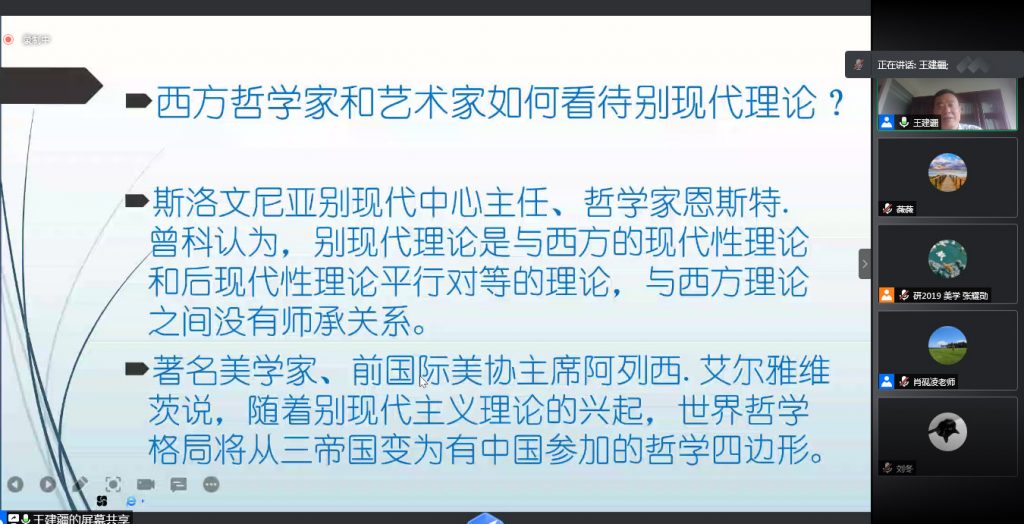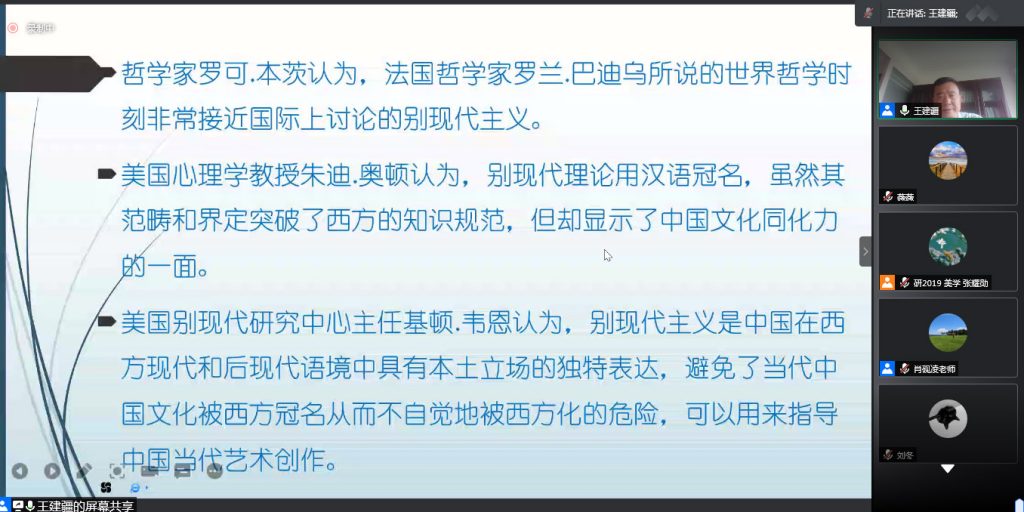Lecture on “Bie in the West” was successfully held by Sichuan Normal University
On the morning of May 20, 2021, a lecture on “‘Bie in the West” was held on the Tencent conference platform by Sichuan Normal University. Professor Wang Jianjiang, member of IAA,director of the Institute of Aesthetics and Aesthetic Education at Shanghai Normal University and a renowned aesthetician, was invited to talk about the theoretical aspects of “Bie” in the West. More than four hundred people, including many scholars and students, attended the lecture.
The lecture started at 9:00 am.
Since its birth in 2014, the Bie-modern theory has aroused extensive discussions in the academic and art circles at home and abroad. In this lecture, Prof. Wang Jianjiang mainly explained the theoretical framework, origin, way of thinking and world influence of the Bie-modern theory, and systematically elaborated the reasons for the popularity of the Bie-modern theory in the West and explored the development path of Chinese philosophy, aesthetics and literature and art.
Bie-modernism is a doctrine that has attracted the attention of the international academic and artistic communities in recent years. Borrowing the origin from the oracle bone inscription of Chinese character Bie which means the separation of flesh and bones, Bie-modernism expresses the idea of distinguishing the true modernity from the pseudo modernity. Universities in the US and the European Union have established academic institutions and websites dedicated to the study of Bie-modernism (CCBMS, CBMS, http://www.biemodernism.net; www.biemodernism.org). Baidu has over 100 million hits about the topic.
First of all, Mr. Wang Jianjiang sorted out the history and current situation of the Bie-modern theory and explained the reasons for its emergence. Since the introduction of the theory at the Sino-Russian High-Level Cultural Forum, six international academic conferences and four international exhibitions of Bie-modern works have been successfully held. Several centers for Bie-modern studies around the world were respectively founded, including the Chinese Center for Bie-modern Studies (CCBMS) owned by Georgia Southwestern State University and the Center for Bie-modern Studies (CBMS) owned by the University of Primorska in Slovenia, and the Italian website for Bie-modernism (www. biemodernism.org; www.biemodernism.net) was specifically established. In addition, Art + Media, an European media magazine, and Filozofski vestnik, have started special columns. The Bie-modern theory has already attracted a great deal of attention and evaluation from scholars both at home and abroad, including the famous aesthetician and former president of the International Association for Aesthetics, Aleš Erjavec, Ernest Ženko, Rok Benčin,and David Brubaker, Enea Bianchi, and the American art historian and director of the Chinese Center for Bie-modern Studies, Keaton Wynn,the American psychology professor Judy Orton. The universal value of the theory is evident from the sensation it has caused in Western countries. The emergence of Bie-modern theory is not only an overview of China’s current social and aesthetic forms, but also a reflection on the underdeveloped state of thought and a call for the revival of Chinese culture.
Secondly, Mr. Wang Jianjiang explains the connotation and significance of the Bie-modern theory. It includes two parts: Bie-modern social reality and Bie-modernism. The Bie-modern reality indicates the current situation of China’s modern, pre-modern and post-modern society, while Bie-modernism is the reflection and criticism of Bie-modern reality, the innovation of discourse, thought, theory and doctrine, as well as the renewal and transcendence of the Bie-modern social reality, so as to realize a fully modern society. “Bie” of the Bie-modern is not only a discursive innovation, but also has ontological and methodological significance. The difference thinking demanded by “bie” belongs to the category of philosophical epistemology, and the difference thinking based on subjectivity is also the basis of philosophical value, individual value, and social value. The aesthetics of Bie-modernism advocates the reflection and criticism of the mixed phenomenon in the Bie-modern society, and thus establishes the aesthetic school and art school of Bie-modernism with the unity of authenticity and particularity.
After the lecture, Doctor Ms. Xiao Yanling made a wonderful commentary. She thought that it was a high-quality academic report with rich connotation, and Mr. Wang Jianjiang not only sorted out the origin and lineage of the emergence of the Bie-modern theory from the chronological perspective, but also analyzed its theoretical connotation, quality, significance and influence from the syncronic perspective, which provided methodological inspiration to our academic research.
Finally, Prof. Wang Jianjiang pointed out that the way of thinking of Bie-modernism is leapfrog pause, which is the need of human survival and development and a philosophy of survival, and its reality is based on the extreme of growth and the predestined karma of “generation, existence, destruction and nothingness”. The formation of contemporary art schools and styles requires the theory of leapfrogging pause (or cutting), and the realization of leapfrogging pause requires a revolution in thinking, that is, a way of thinking that seeks differences. Only by focusing on the establishment of marketplace of ideas and the formation of zhuyi (doctrines) can a new era of aesthetics and art be opened up. In addition, Wang also points out that the reason why Bie-modernism is discussed in the West is that it is not only a product of original thought, thought revolution, marketplace of ideas, and thought sharing, but also an inevitable trend of historical development, and only on the basis of distinguishing the true from the false can it truly go global and influence the world.



